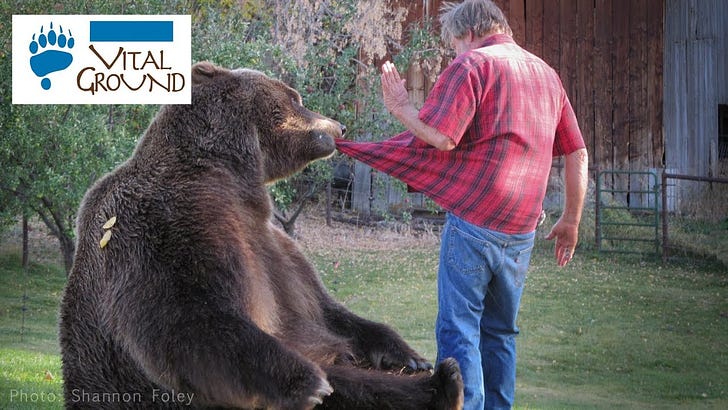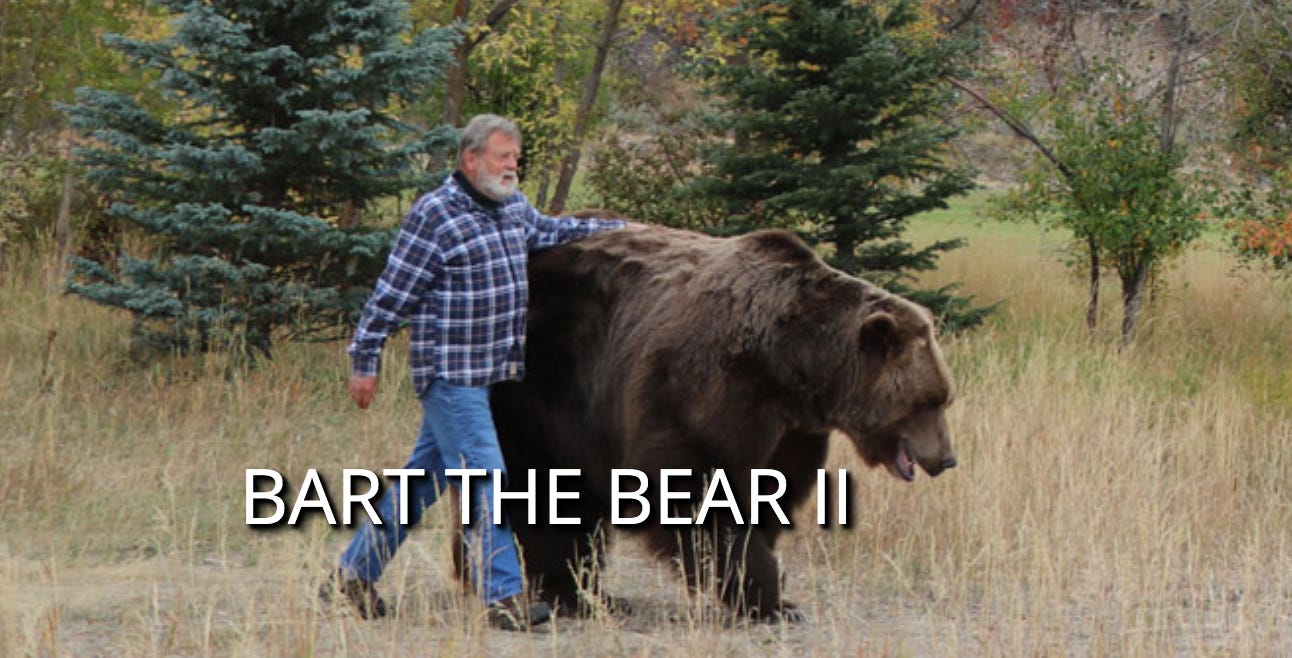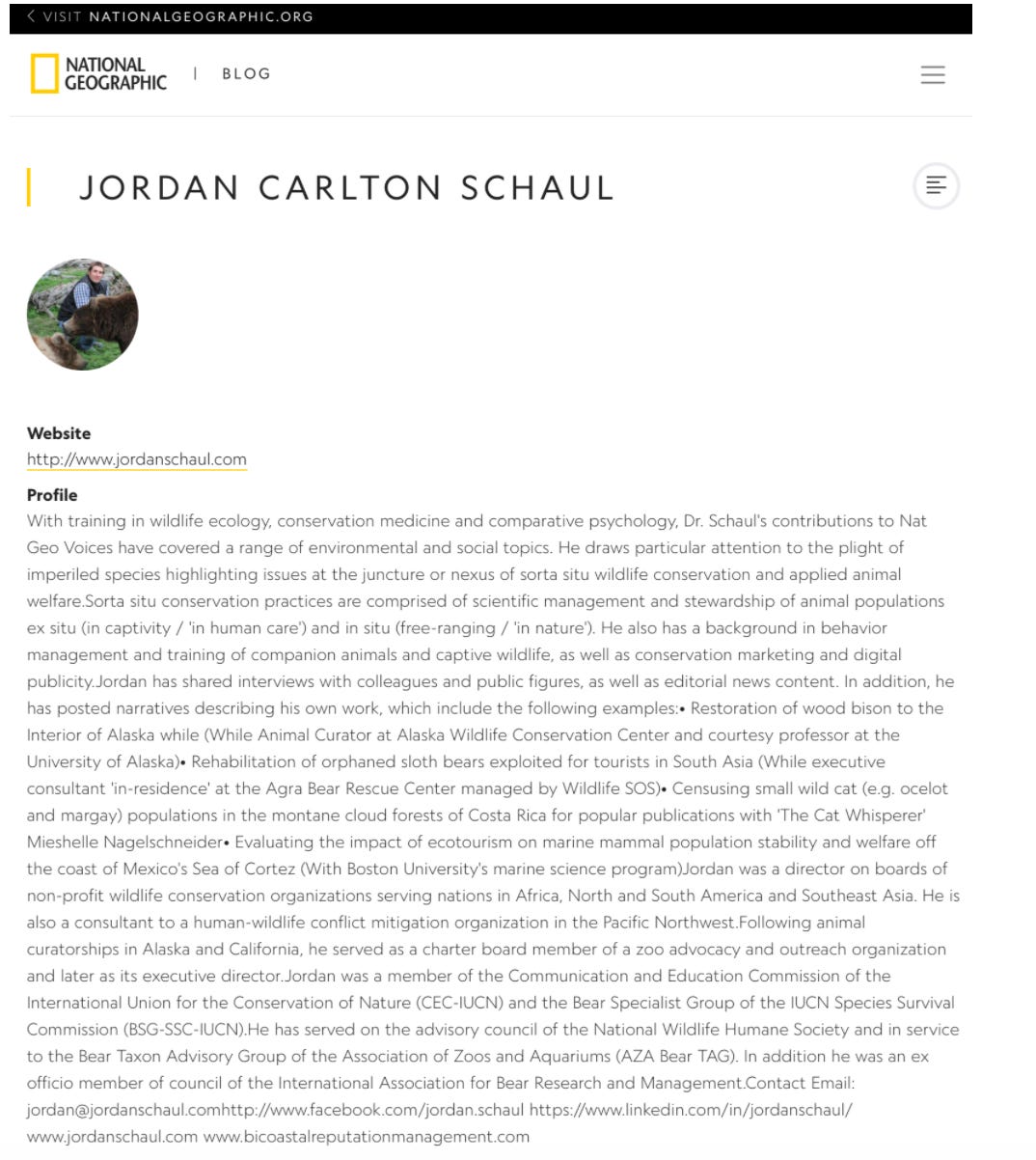Inspired by Bart the Bear, Vital Ground Foundation Protects Grizzly Bear Habitat
By Jordan Schaul | National Geographic | October 1, 2013 (Updated October 9, 2021)
Doug Chadwick first met with Doug Seus, arguably the world’s preeminent bear trainer, while Chadwick was researching an article on grizzly bears for National Geographic magazine. Chadwick, a highly acclaimed natural history writer, had seen a photo of Seus riding on the back of an apparently tame and well-trained adult male grizzly bear. Then one day in 1984, he suddenly showed up on the Seus’ doorstep to talk to the famous animal wrangler and meet his ursine friend. Chadwick was eager to get some perspectives on grizzlies from Seus who lives and works on a ranch in Utah with his wife Lynne and their posse of large animal actors. At the time, the animal trainer’s primary pupil was a 1500 lb Kodiak brown bear named Bart.
The story of Vital Ground begins 5 years later when the two Dougs traveled together on safari in East Africa where Chadwick was working on an elephant story. The conversation turned to the great landscape of colonial America. As the two peered out over the Masai Mara in awe of migrating wildebeests, they contemplated a time in American history when buffalo still roamed the West and California had grizzly bears. They thought about what they could do to restore larger areas where America’s panoply of great native creatures dominated the landscape.
Concerned over the status of approximately 1000 grizzly bears or fewer left in the lower 48 in the mid-80s, Chadwick and Seus agreed that a supplemental approach to protecting the iconic carnivore was warranted, especially because the population did not appear to be recovering very strongly from its low point.
Traditional conservation practices seemed to have been of limited effectiveness for such a wide-ranging species. Even though the population has been on the rebound with current numbers estimated to be around 1600 individuals, the grizzly is still relegated to living on land comprised of only two percent of its historic range in the contiguous United States.
In an increasingly crowded and urbanized world, there are limitations to what existing protection can offer such a wide-ranging carnivore species. The grizzly was listed as “threatened” in the lower 48 in 1975. Still federally protected in 1990, Seus and Chadwick launched the Vital Ground Foundation to safeguard grizzlies for the foreseeable future.
Bear Biology & Management…
Wildlife ecologists tend to study the measurable indicators that indirectly tell us what a bear does for a living and how bears are distributed across the landscape so they can be best managed and conserved. Essentially, these barometers tell us how a conservation-sensitive species is doing under existing regulatory protections.
Field biologists have done an exemplary job to recover grizzlies. However, as mentioned, their role is to collect data and study bears largely in terms of the health of their populations. In addition to raw numbers, researchers study population genetics, demography, and ecology and examine habitats for suitability and conservation management potential. They also look for areas where habitat restoration can be of benefit to bears and other wildlife. Their assessments help immensely in instructing policymakers and others in the conservation arena to make the best decisions for the preservation and the protection of habitat or what is left of it.
The focus of scientists and wildlife managers is not to raise captive bears nor is it to learn behaviors of individual animals on a very intimate level as the two Dougs and other trainers and naturalists have come to know them. One way to get to know a bear is to raise one. Another way is to live among them, which is not recommended or encouraged. Finally, as Chadwick knows, one can observe them in nature as he did. The naturalist has had a wild grizzly brush up against him, but he has not lived among bears. He views them respectively from a safe distance. As one of America’s esteemed nature writers, he has come to know bears in nature by watching their behavior for hours at a time. He has logged hundreds, if not thousands of hours, observing brown bears in Montana, Alaska, British Columbia, and Central Asia.
When a biologist meets a bear in the wild, the interaction can be intense and somewhat stressful, at least for the bear and for the bear biologist. If a bear, for example, is discovered in a trap and then tranquilized, from the bear’s perspective, it is probably not having a good day. Today, biologists spend even less time in the wild tracking and trapping bears, because technology and innovation make less invasive methods of learning about bears possible.
Chadwick and Seuss are not research biologists, although Chadwick was trained as a wildlife biologist and lives near Glacier National Park. He knows Montana’s grizzlies particularly well. As a renowned nature writer, he communicates wildlife science and natural history in an accessible way for lay audiences around the globe.
Several people have tried to live among wild bears, and among them, a few have done it irresponsibly. Some have even lost their lives trying to live with bears. Others, perhaps more cognizant of the risks, have taught us a lot about bears through getting to know individual animals.
A Controversial Conservation Success Story…
Bear biologists have contributed so much to what we know about bears and what they need to survive through intensive monitoring, that they have learned to manage remnant and long-isolated populations quite sustainably. Thanks to conservation efforts of the Interagency Grizzly Bear Committee and organizations like Vital Ground, the southernmost population of grizzly bears inhabiting the Yellowstone Ecosystem has recovered.
Albeit controversial, the grizzly was removed from the list of threatened and endangered species under the Endangered Species Act in May of 2007. Due to public outcry from environmental organizations and subsequent litigation, the grizzly was reinstated as a “threatened” species in 2009 and is again a beneficiary of federal protection. The Yellowstone population is now estimated to number approximately 700 bears.
The Founding of Vital Ground…
Almost three decades ago, when Doug and his wife Lynne, and Doug Chadwick pondered how our iconic wildlife heritage once flourished across the plains and mountainous landscapes of the great West, they began to envision a future for the grizzly bear. Grizzlies still occur in the lower 48, but their range is restricted to three states (MT, ID, and WY) plus an occasional transient population, which is found in Washington State’s North Cascades.
The Seus’ decided to buy some property in Montana—a habit deemed not just appropriate and suitable—but considered prime habitat for grizzly bears. They purchased 240 acres of wildland adjoining protected areas in Pine Butte Preserve along Montana’s eastern front of the Rocky Mountains. One thing lead to another and Vital Ground was launched as a land trust dedicated to protecting grizzly bear habitat for the iconic umbrella species.
Doug Chadwick has said that from the beginning he realized the benefit of protecting as much private land near existing core habitat or linkage areas as possible, especially when the surrounding area is largely private land. This is because bears and other wildlife species may select different habitats to move across the landscape than the type of habitat that they choose for other purposes. Although some public land has been protected because of the suitable species-appropriate habitat it offers, it may not offer a habitat that bears prefer to use when crossing or transitioning among different landscapes.
To date, Vital Ground has purchased over 600,000 acres of private lands and “works cooperatively with landowners, local communities, and state and federal agencies to address the issue of habitat fragmentation by permanently protecting crucial lands [for not only grizzly bears],” but [also] other wide-ranging wildlife which utilize grizzly habitat."
Vital Ground is not in the practice of taking land from people for the sake of salvaging habitat for grizzly bears. They are interested in rewarding people for making their land accessible and permeable to wildlife, which are practices consistent with what people who live in grizzly country are already doing. Many people move to Montana and the Western states to live in proximity to raw and relatively undisturbed nature.
By negotiating with landowners with property adjoining public lands like national forests, Vital Ground helps communities increase the value of private land and augment the land already set aside for wildlife. Again, their goal is to make it possible for animal populations to safely move from one protected area to another.
Through conservation easement programs, Vital Ground pays people to accommodate the movement of wildlife on their property. “In some cases,” says Chadwick, “Vital Ground pays people to keep doing the right thing on their own land for the benefit of wildlife.” This may include implementing seasonal management of livestock or continuing with practices that accommodate the movement of bears.
To accrue the 600,000 plus acres for grizzlies, the land trust has partnered with Yellowstone to Yukon, Montana Fish, Wildlife and Parks, The Trust for Public Land, Five Valleys Land Trust, William H. Donner Foundation, and The Metabolic Studio. In addition, Vital Ground has worked to retire grazing allotments and recover such properties for wildlife. In partnership with the National Wildlife Federation, Vital Ground has restored land once designated as federally protected wilderness for bears and other majestic North American species.
Vital ground executive director Gary Wolfe has often addressed the importance of wildlife linkage on the landscape and the need to protect private lands to help support the movements of one of the world’s two largest terrestrial carnivore species.
He said, “From housing developments to commercial sites, from roads to railroads, grizzlies and other wildlife species face numerous human barriers.” According to Wolfe, “When contiguous blocks of habitat are broken into pieces from human activities, the result is habitat fragmentation.”
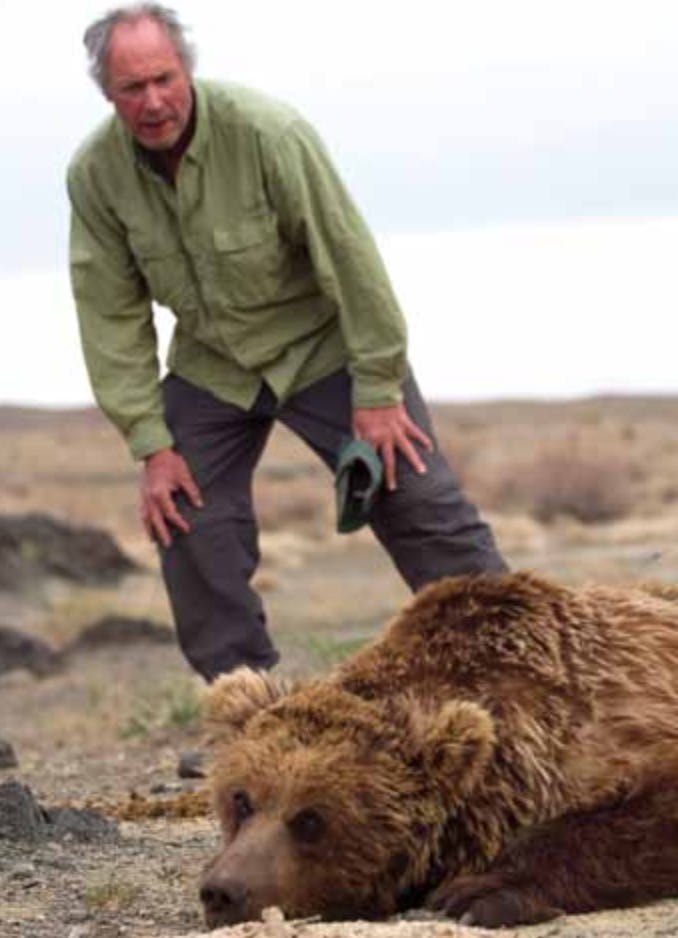
As an example, in the Northern Rockies, Vital Ground “is working with biologists to identify, where grizzly/wildlife movement opportunities still exist and are trying to protect these potential linkage areas using voluntary conservation easements or by acquiring the property from willing sellers.”
According to Vital Ground’s Ryan Lutey, “These corridors will help restore and maintain the habitat connectivity between the large blocks of public land in the northern Rockies region and foster wildlife movements between ecosystems across a permeable landscape. Intact linkage areas allow grizzlies and other wildlife to disperse to new ranges and exchange genes between populations.”
In a recent post, I mention some other activities Vital Ground supports in and near one of the five ecosystems where grizzly bears exist on public lands (under federal protection). These include conservation efforts for the grizzly bears that will hopefully increase long-term sustainability for the respective populations in these four ecosystems, as the North Cascades and Selway-Bitterroot/Central Idaho ecosystems are not inhabited by resident grizzly bears.
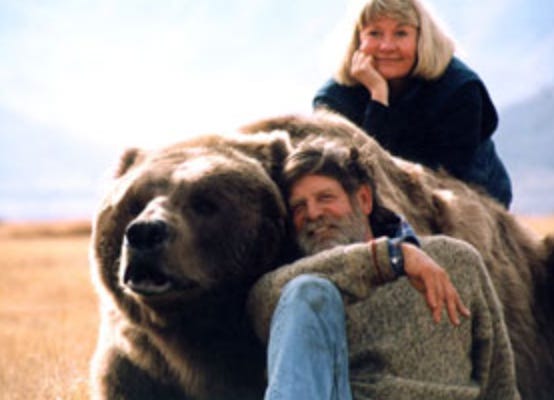
The Legacy of Bart the Bear…
There is nothing like raising an orphaned grizzly bear. I’m not talking about bringing a 1200-pound brown bear into the kitchen, but cultivating that extraordinary bond with the planet’s largest terrestrial carnivore. With the support of his wife Lynne, this is exactly what Doug Sues did when he raised 9’2, 1500 lb Bart the Bear. The Sues’ offered to raise a Kodiak cub born to a sow at a zoo. And by all accounts, he had a great life before it was cut short from cancer. Today Doug & Lynn continue to raise bears and wolves at their ranch, which doubles as an animal training campus (Wasatch Rocky Mountain Wildlife, Inc.) in Utah.
Lynne said, “From the time we got him in 1977, and until his death in 2000, Bart was a truly magical animal. His film career took us on many grand adventures—from the majestic peaks of the Austrian Alps and the Alaska wilds to the backstage of the Academy Awards.” Notably, Bart starred role in the 1989 movie, The Bear.
The animal actor has appeared on the big and small screen, in feature films, and in documentaries. His breathtaking performances have wooed and moved audiences the world over in riveting critically acclaimed motion pictures. In its totality, Bart’s illustrious movie career included appearances in 15 feature films and spanned 17 years (1980-1997). His film credits include work alongside Academy Award winner Sir Anthony Hopkins, and nominees Dan Aykroyd, Annette Bening, and Brad Pitt. Bart also appeared with Sean Penn and Daryl Hanna.
“Bart the bear holds an envelope naming a winner at the 1998 Academy Awards. Bart was once nominated for an Oscar for his role in The Bear, which was as close as any animal has ever come to winning an Academy Award. In the film, Bart had to be gentle to another bear’s cub. (Most bears are too aggressive to do so.) Animal actors are classified as props, not characters.”- Adapted from National Geographic World, May 1999
In addition to features, Bart appeared in 15 documentaries and 8 television programs between 1980 and 1999, including National Geographic’s The Grizzlies and National Geographic Explorer. Highly regarded, the film Legends of the Fall was released in 1994 and was an immediate success. The movie jumped to number one at the box office and grossed 14 million dollars in its first week. The 1930’s era drama showcasing the American West was ultimately nominated for three Academy Awards and a Golden Globe. The film also earned producer/director Edward Zwick a nomination for Best Director, and the film ultimately won an Oscar for Best Cinematography.
“Of all the movie stars I’ve ever worked with, Bart the Bear is as talented, cooperative, and charismatic as the best of them. He takes no time at all in make-up, never wants to stay in his trailer, and does all his own stunts. I can’t wait to work with him again.”- Ed Zwick, Director, Legends of the Fall
Legends may have earned Brad Pitt an Oscar nomination, but it made “Bart the Bear” a household name if he wasn’t one already. Ultimately grossing 66 million dollars, the movie was quite a success.
“Academy Award board member Ernest Gold moved to have a special achievement Oscar presented to Seus for The Bear since the organization had received so many ecstatic letters from biologists. But Gold’s fellow members never watched the film and the matter was brought up at the wrong meeting so that it was only when The Bear was finally nominated for Best Editing and screened that the other board members saw it and admitted they’d been too hasty in their decision.”- Video & Entertainment, May 1990
What I learned from Doug Sues and Doug Chadwick…
In my conversations with Doug Chadwick and Doug Seus, I chatted about nature writing and training bears and learned something about Vital Ground’s vision and philosophy. Seus and I shared perspectives about the innate intuition required to successfully develop a rapport with these formidable animals. To paraphrase Doug, “Not everyone has the intuition to work with animals in this capacity and it is not something you learn in school.” Because he also spent a great deal of time studying the plight of the grizzly bear, he wanted to do something for these “beasts of legend”. He shared that it was, in fact, Bart who inspired Vital Ground.
Chadwick discussed his career as a nature writer and talked about his travels. He specifically shared about the direction Vital Ground has taken since the purchase of their first property in Montana and his hopes for the 600,000 acres they have more recently purchased. Although Chadwick has traveled the world and worked with the most revered and charismatic megafauna, he says there is something special about our native grizzly bear in all its majesty and particularly because they live right in his backyard.
Both Seus and Chadwick recognize the interesting dichotomy reflected in the history of the Vital Ground Foundation. On one hand, a family of captive grizzly bears continues to inspire the protection of their wild counterparts through safeguarding private lands. The protection of habitat is conferred through a land trust and not what might have been expected such as more focused species conservation or habitat restoration programming.
Void of ego and full of hope, Chadwick and Seus are innovative visionaries and consummate stewards of nature. They are eager to focus on advancing the interest of the land trust, which started with humble beginnings and the inspiration of a bear named Bart. Vital Ground is poised to take a place in history as it shapes a more sustainable future for the American Icon, the grizzly bear.
As for Bart the bear who died far too young at age 23, Doug and Lynne Seus have this to say: “His legacy went far beyond his film career. he is the “spokesbear” for the animal cancer center at Colorado State University, but his greatest role was as an ambassador of Vital Ground has procured threatened wildlife habitats in Idaho, Montana, and Alaska. Because of Bart’s life in captivity, many of his wild brothers and sisters are able to roam free.” –http://www.bartthebear.com
(All photos are courtesy of Vital Ground/Bart the Bear websites)
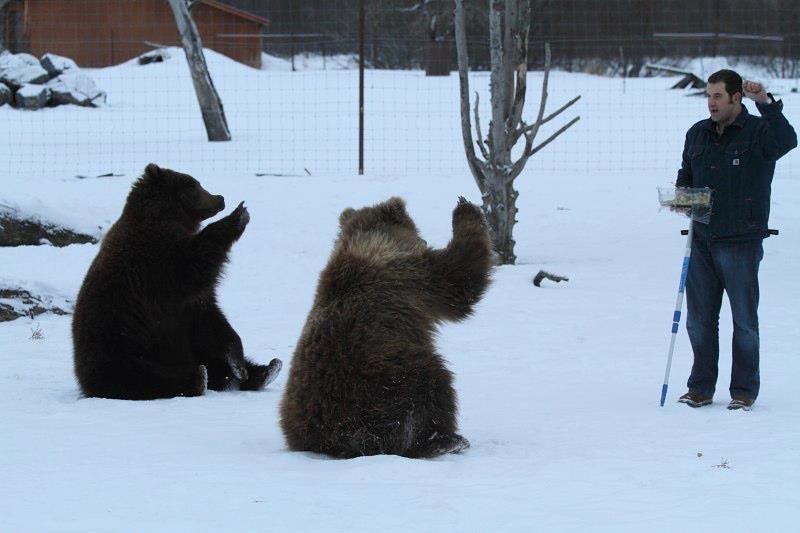
ABOUT NATIONAL GEOGRAPHIC SOCIETY
The National Geographic Society is a global nonprofit organization that uses the power of science, exploration, education and storytelling to illuminate and protect the wonder of our world. Since 1888, National Geographic has pushed the boundaries of exploration, investing in bold people and transformative ideas, providing more than 14,000 grants for work across all seven continents, reaching 3 million students each year through education offerings, and engaging audiences around the globe through signature experiences, stories and content. To learn more, visit www.nationalgeographic.org or follow us on Instagram, Twitter and Facebook.
MEET THE AUTHOR
Jordan Carlton Schaul With training in wildlife ecology, conservation medicine and comparative psychology, Dr. Schaul's contributions to Nat Geo Voices have covered a range of environmental and social topics. He draws particular attention to the plight of imperiled species highlighting issues at the juncture or nexus of sorta situ wildlife conservation and applied animal welfare. Sorta situ conservation practices are comprised of scientific management and stewardship of animal populations ex situ (in captivity / 'in human care') and in situ (free-ranging / 'in nature'). He also has a background in behavior management and training of companion animals and captive wildlife, as well as conservation marketing and digital publicity. Jordan has shared interviews with colleagues and public figures, as well as editorial news content. In addition, he has posted narratives describing his own work, which include the following examples: • Restoration of wood bison to the Interior of Alaska (As Animal Curator at Alaska Wildlife Conservation Center and courtesy professor at the University of Alaska) • Rehabilitation of orphaned sloth bears exploited for tourists in South Asia (As executive consultant 'in-residence' at the Agra Bear Rescue Center managed by Wildlife SOS) • Censusing small wild cat (e.g. ocelot and margay) populations in the montane cloud forests of Costa Rica for popular publications with 'The Cat Whisperer' Mieshelle Nagelschneider • Evaluating the impact of ecotourism on marine mammal population stability and welfare off the coast of Mexico's Sea of Cortez (With Boston University's marine science program) Jordan was a director on boards of non-profit wildlife conservation organizations serving nations in Africa, North and South America and Southeast Asia. He is also a consultant to a human-wildlife conflict mitigation organization in the Pacific Northwest. Following animal curatorships in Alaska and California, he served as a charter board member of a zoo advocacy and outreach organization and later as its executive director. Jordan was a member of the Communication and Education Commission of the International Union for the Conservation of Nature (CEC-IUCN) and the Bear Specialist Group of the IUCN Species Survival Commission (BSG-SSC-IUCN). He has served on the advisory council of the National Wildlife Humane Society and in service to the Bear Taxon Advisory Group of the Association of Zoos and Aquariums (AZA Bear TAG).

